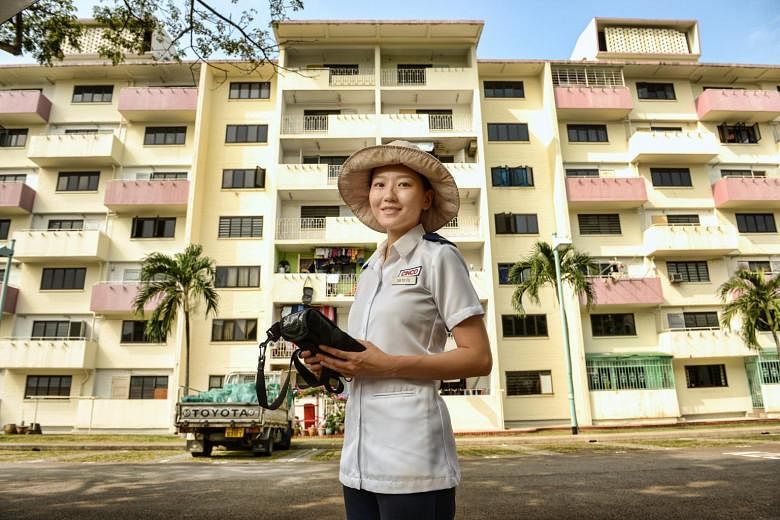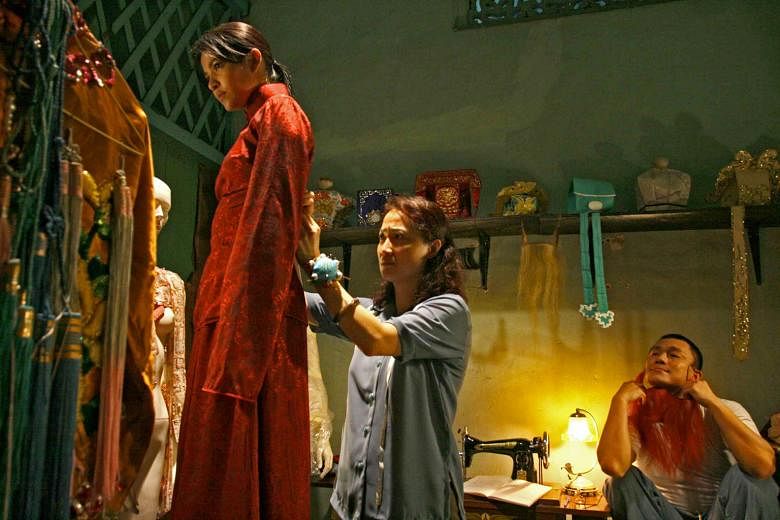Location, location, location. It is a mantra that property experts take to heart, but it might well be a lament for home-grown film-makers. The fact that Singapore is a compact, bustling city can make it challenging to pin down that perfect spot. They take Boon Chan and John Lui behind the scenes on the key filming locales for their movies.
Director: Kelvin Tong
Movie: The Maid (2005)
Location: Peranakan house, Koon Seng Road
When Tong was preparing to make his third movie, The Maid (2005), he knew it was crucial to find a house that suited the horror film's tone.
"Every horror flick needs a house with oodles of atmosphere and character," the 40-year-old says.
Hollywood has its horror-ready ramshackle farm houses and crumbling Gothic mansions. Tong found the perfect Asian equivalent when he saw a Peranakan shophouse in the Joo Chiat area.
"I knew it had to feature in The Maid. It was old, really spooky and so, so South-east Asia. It was perfect as the setting for a horror film set in Singapore during the Hungry Ghost Festival," he says.
In the film, a young domestic helper Rosa (Alessandra de Rossi) moves into the house to care for an ageing couple and their mentally disabled son, only to find horrific apparitions following her around the home.
The crew stood aside and let the house do the work of being creepy, says Tong.
"The original wooden floors creaked, the stairs looked and sounded like they were going to collapse any moment. Some wooden walls on the second floor had holes patched by newspapers going back to the 1940s and 1950s," he says.
He did get one thing wrong when he picked the house, however. He forgot to take into account the din caused by cars headed to pubs in the area. The noise ruined sound recording, forcing the crew to block traffic when cameras were rolling. Drivers were not pleased.
"Imagine trying to get those drunkards on their way home from the bars in Joo Chiat to stop for five minutes. It was hell," he says.
John Lui

Director: Eric Khoo
Movie: Mee Pok Man (1995)
Location: Hua Bee coffee shop in Tiong Bahru
Khoo's debut feature, Mee Pok Man, is arthouse horror. It was appropriate that shooting the pivotal Hua Bee coffee shop scenes was, in Khoo's words, "horrifying".
"Everything that could go wrong went wrong," he says. Problems with cameras, sound, lighting and artist performances piled up. The location is where Bunny, a prostitute (Michelle Goh), is served by the noodle seller of the film's title (Joe Ng), a man who dreams of prying her from the hands of pimp Mike Kor (Lim Kay Tong).
It was an ominous start to the first shooting day of Khoo's first feature. The crew, new to working on features, filmed from dawn to near midnight that first glitch-filled day, but failed to complete key shots.
"We were all so demoralised," the 50-year-old says. He apologised to Lim, who had worked in the United States.
"He looked at me and said, 'Hollywood takes longer,'" says Khoo. That remark cheered Khoo immensely. After a night's rest, everyone came back and got it right.
Today, the 50-year-old Hua Bee, at 78 Moh Guan Terrace, is where diners come for bright, chilli-red mee pok in the day. At dusk, yakitori bar Bincho takes over the space. A poster of the movie hangs next to the kopi station.
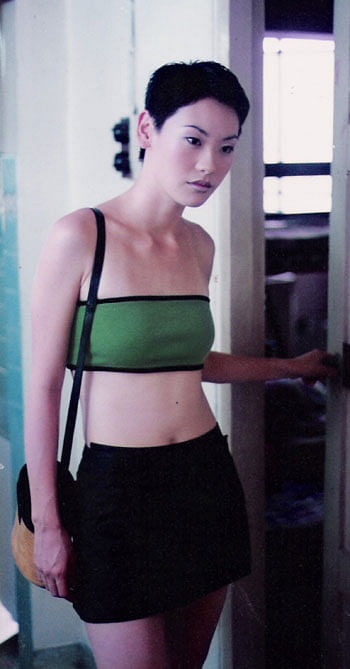
Movie: 12 Storeys (1997)
Location: Stirling Road HDB flats
The crew for Khoo's next feature, 12 Storeys (1997), spent the most time at the HDB blocks around Stirling Road.
One of the film's four stories, Sister's Keeper, was shot in a Stirling Road flat that belonged to a friend's mother. Restaurant scenes featuring Ah Gu (Jack Neo) chatting with buddies were filmed at the nearby Zi Yean zichar restaurant, which has since moved to Lengkok Bahru.
The interiors for the rest of the stories were filmed in Tiong Bahru and Ang Mo Kio.
In Sister's Keeper, Meng (Koh Boon Pin) is the domineering, straight-laced brother who struggles to keep wild-child sister Trixie (Lum May Yee) on a tight leash.
Besides the good food at Zi Yean, Khoo remembers a cameraman who jury-rigged a contraption to capture the point of view of a suicidal person who jumps off a building.
A rented camera worth $100,000 was attached to a bungee, then thrown from the 12th floor.
"When I saw the camera go down, my stomach went down with it," says Khoo. The falling camera was dangerously close to impact when the elastic rope arrested its fall, yanking it back up. The crewman asked Khoo if he would like to repeat the stunt.
"I said, 'No, no, no, no, no,'" says Khoo. As luck would have it, that single take gave him good footage.
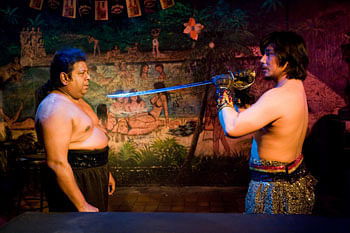
Movie: My Magic (2008)
Location: Bar in Orchard Towers
For the 2008 father-son drama My Magic, Khoo was looking for a stage for his main character, the magician Francis (Francis Bosco), to perform on. But it could not be just any stage. The location had to echo the world-weary yet optimistic character of Francis. It had to be "not sleazy, but it had to have a lot of texture".
Khoo found the ideal place in Crazy Horse bar on the fourth level of Orchard Towers building, a locale known for its cluster of hostess bars.
The thing that Khoo was most excited about was a hand-painted mural on one wall, done by an anonymous artist. He could see his magician character performing against it.
The mildly titillating, kitschy painting, depicting bikini-clad girls at play, was so right in tone that Khoo used it without the need for touch up.
"I didn't have to do any art direction," he says.
Khoo says he could not have encountered more friendliness when he filmed there: "A friend who was helping with the production knew the lady in charge. She was a lovely lady in her 50s."
His crew were told to make themselves at home and she served them drinks. The only instruction given by the lady boss: No drug-taking on the premises.
John Lui
Watch the interview with Eric Khoo at str.sg/PLU

Director: Jack Neo
Movies:
Ah Boys To Men (2012)
Ah Boys To Men 2 (2013)
Ah Boys To Men 3: Frogmen (2015)
Location: Military training areas in Pulau Tekong and Sembawang Naval Base
Hit film-maker Neo laments that filming on location in Singapore is "quite a headache". After all, there are only so many ways that one can try to dress up HDB blocks.
He adds: "We try our best to scout for locations which have not been seen before because audiences get tired of seeing the same views as well. But given Singapore's small size, what spots can be truly fresh? Not too many."
That is why he points out that the locations used for his national service-themed Ah Boys To Men films are "quite special" as they are normally out of bounds.
Neo, 55, adds: "Few people have had the opportunity to film in training areas. We were able to do so because we worked with the Ministry of Defence."
He ventured to military areas on Pulau Tekong, the Naval Diving Unit in Sembawang and restricted training areas in Lim Chu Kang.
"I was very excited to shoot there because even parents of trainees can't get access to these places. I'm really thankful to Mindef for giving us the permission to do so as that makes the movies more authentic."
He notes that it is actually common in Hollywood to shoot inside studios, but this is difficult to carry out in Singapore because of budget constraints.
Money issues aside, it is sometimes necessary to venture outdoors.
As Neo says: "In the case of the Naval Diving Unit, I had to go to the naval base to shoot because only that location will give audiences that 'feel'. Picking the right location will definitely make an impact on the audience."
Boon Chan

Director: Chai Yee Wei
Movie: That Girl In Pinafore (2013)
Location: Bras Basah Complex
For xinyao devotees, Bras Basah Complex was a place of pilgrimage.
At the height of the Mandarin Singapore songs movement in the 1980s to the early 1990s, practically every artist who released an album would perform and promote his music there.
The building was also known as shu cheng (Chinese for "books city") - many students, especially Chinese-educated ones, would hang out there and get their supply of textbooks, stationery and art materials. Film-maker Chai, 39, remembers heading there for his fix of Chinese martial arts novels as well.
He concludes: "So it is a place of historical significance when it comes to xinyao - the main theme of my movie."
That Girl In Pinafore is a coming-of-age story and xinyao is its soundtrack. For the film, Chai wanted to recreate a scene of a xinyao concert being staged.
There was no question of picking another location as Bras Basah Complex "is too unique and identifiable". The concerts took place in an open-air space within, with fans crowding onto the upper floors overlooking the stage.
Chai adds: "It would be hard to recreate this space without major renovations or computer graphic work. And if we are to use somewhere else and pretend it is Bras Basah Complex, xinyao fans would pick that out immediately."
After securing permission to film there, he ran into a very specific problem.
"There were advertising banners all over with telephone numbers consisting of eight numbers and Internet addresses. I was shooting a film based in the 1990s when the telephone numbers then had only seven numbers and there was no Internet."
He tried to avoid the tell-tale numbers as much as possible and says there was no need for digital manipulation in post-production.
The shoot was done in August 2012 and the timing turned out to be fortuitous. "Right after filming, they started renovations and doing up all the scaffolding."
Boon Chan

Director: Tan Pin Pin
Movies:
Singapore GaGa (2005)
To Singapore, With Love (2013)
Location: Changi Airport
To many, Changi Airport is a gleaming beacon of efficiency that is a symbol of Singapore's sleek modernity and economic success.
But each time film-maker Tan, 46, lands on the tarmac, she experiences a mix of emotions.
She points out: "There is a frisson every time one touches down in Changi. And depending on where one comes from, one may feel relief, dread, sadness or thrill. Changi Airport symbolises this tumble of emotions. It symbolises an escape from Singapore, it also symbolises the relief of coming home, all feelings which find expression in those films."
In both Singapore GaGa and To Singapore, With Love, there are scenes of a plane approaching the airport.
Singapore GaGa is a whimsical musical odyssey which winds its way across the island, while To Singapore, With Love tells the stories of nine political exiles, some of whom have been away for as long as 50 years.
In her short film 80km/h (2003), a 38-minute work shot in one take and which documents a journey on the Pan Island Expressway from end to end, the airport is seen from a car.
The Woodlands Causeway could "symbolise escape and homecoming too", but she says: "Nothing beats the bump of the plane tyres on Changi's tarmac. The relief of a safe landing bound together with the mixed emotions of being back in Singapore is particular to that moment and place only. I try to immortalise this in my films."
There is one specific moment that occurs in both Singapore GaGa and To Singapore, With Love.
Tan says: "I love the welcome message from the air stewardesses. They are always so chirpy, oblivious to the actual mood of the passengers. 'Ladies and gentlemen, welcome to Singapore. And to all Singaporeans, a warm welcome home!' Indeed."
Boon Chan
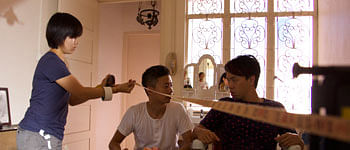
Director: Han Yew Kwang
Movie: Rubbers (2014)
Location: Pink terrace house in Swanage Road
Adam is a condom-hating playboy who gets into a sticky situation with Japanese porn actress Momoko. It is the most out-there segment in writer-director Han's sex comedy Rubbers. As he puts it, the "weirdest, most interesting and fun scenes" take place in Adam's home, so the venue he chose to shoot at had to have enough character to match the story.
Upon a friend's recommendation, he checked out a terrace house on Swanage Road, which belongs to Mr Elgar Kwek, 39, owner of Little Olde Gallery. The moment he stepped inside, he knew he had found the perfect place.
Han, 39, declares: "The house is weird, stylistic, retro and charismatic enough to be Adam's house."
With its pink coat of paint and retro detailing and furnishings, the house has plenty of character all right.
He ticks off "antiques, classic and vintage music instruments, paintings, cameras and furniture" among the treasures it holds and adds: "We were afraid that we might damage them in the filming process as Alaric (Tay, who plays Adam) and (Momoko actress Oon) Shu An had to move around the house in awkward positions."
Boon Chan

Director: Wee Li Lin
Movie: Centrepoint Kidz (2015)
Location: Centrepoint
Before Facebook and Instagram came along, young people hung out at malls more often.
Film-maker Wee, 41, remembers spending a large part of her youth at one venue in particular. "I used to study at Singapore Chinese Girls' School at Emerald Hill and Centrepoint was a refuge and a place where I could gawk at the cool Centrepoint Kids."
Last year, she revisited her youth by making a short film, Centrepoint Kidz, about the sub-culture of 1980s mall kids.
Fortunately for her, "some areas of Centrepoint remained quite 1980s". "The golden escalators, railings and carpark were very much the same," she says.
She even found a shop there with a retro look. "Thankfully, Milan Shoes has retained its classic look since the 1980s. So we had several major scenes of the kids shot outside it."
It was de rigueur for the cool kids to be togged out in fashion-forward outfits, watching and being watched as they leaned against railings and hung around aisles.
There was also a major breakdance face-off between two rival gangs that was shot in the carpark. Wee says with a laugh: "I think some drivers were a little miffed. They didn't know we were filming and thought we were some punk kids crowding up the carpark. But the management was very patient and understanding with us."
On the other hand, the crew received the thumbs-up from some other passers-by.
Wee recalls: "When the kids were all dressed up and we were shooting some scenes in the aisles, some people in their 40s stopped my actors to say they used to be like them. They were former CP Kids and that was how they really looked. Kudos to our wardrobe and hair team."
Boon Chan
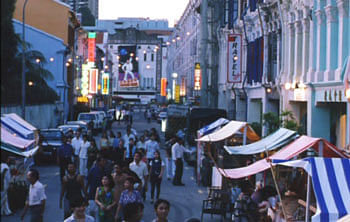
Director: Glen Goei
Movie: Forever Fever (1998)
Location: Mosque Street
Chinatown in the 1970s was a hive of bustling activity and life spilled onto the streets. Hawkers and sellers competed for attention with their colourful wares as the smell of food wafted through the air.
This is the Chinatown that writerdirector Goei remembers fondly and he sought to recreate it for his gongfu-meets-disco dramedy Forever Fever, set in 1977. Adrian Pang plays Bruce Lee-idolising Ah Hock, who joins a dance competition to buy his dream motorcycle.
The character lives on Mosque Street with his family and there are key overview shots of the area bookending the film - one in the evening at the start and one at dawn at the end.
Goei, 52, explains: "It is important because it sets up the entire context of the movie and it shows where he lives. And you can see the painted poster of a film being put up at Majestic Theatre. It is where Ah Hock watches a film that changes his life."
That was none other than Forever Fever, a thinly disguised version of the American dance hit starring John Travolta, Saturday Night Fever (1977).
But at the time he was making the film in 1997, Mosque Street was just a "normal street" without the colours he remembers. It meant he had to recreate a passage teeming with street sellers, roadside stalls and carts with overhead awnings as well as passers-by milling about. To pull off this "very difficult" task involved a total of about 100 extras and crew members.
He says drily: "I was ignorant and naive."
Despite the challenges, he never considered shooting anywhere else.
"The film is a lot about Ah Hock's cultural identity. Chinatown sets that tone. He's a Bruce Lee fan but, suddenly, he's caught in the clash of cultures between East and West. I felt this was where Singapore was at in the late 1970s."
Boon Chan

Director: Boo Junfeng
Movie: Sandcastle (2010)
Location: Semi-detached home in Katong
In this coming-of-age drama tinged with commentary about Singapore's forgetting of recent history, writer-director Boo, 31, searched for a home that looked right for the characters of the grandparents.
"I was looking for one of those very old single-storey houses. We went knocking on doors in estates in Changi and Serangoon, but couldn't find an owner willing to allow us to shoot," he says.
Through a friend, they finally found what they were looking for: A single-storey, semi-detached home in Katong kept in its original, unrenovated state.
"It belonged to an elderly couple who had passed away and their family decided to preserve the place in their memory. The rooms and furniture were all kept in place, which made the house perfect for our film," says Boo.
Scenes shot inside the house, a symbol of a past that refuses to stay buried, feature the narrow interior corridor, typical of houses built in that period. The grandparents (played by Ng Jing Jing and Yap Gut Ghee) and teenager En (Joshua Tan) move and speak from corridor to room and vice versa as the boy tries to break the wall of shame and silence surrounding his father's involvement in the 1950s Chinese middle-school political movement.
The home on the other side of the dividing wall was also used as a shooting location, for a film of a very different kind. The romantic comedy The Wedding Game (2009), starring Christopher Lee and Fann Wong, was partly shot in the modern three-storey building next door.
"I used to joke that our half of the house is for an arthouse film, while the other half was for a commercial film," says Boo.
All things must pass in Singapore, and if you want to see the old place, you have to do it on DVD.
"I passed by the place recently and realised the old house is gone," says Boo.
John Lui

Directors:
Jasmine Ng, Kelvin Tong
Movie: Eating Air (1999)
Location: The CTE tunnel
Tong's first full-length movie might have been low-budget, but it did include one big-budget scene: the mass motorcycle chase and fight sequence in the Central Expressway tunnel in the film's climax.
The menacing, cave-like but urban-cool feel of the concrete walls fit Eating Air's themes of claustrophobia. Starring first-time actors Benjamin Heng (Ah Boy) and Alvina Toh (Ah Girl), the movie centred on the theme of youthful romanticism colliding with the realities of life in an urban pressure cooker.
"The tunnel was opened just before we shot and immediately, Jasmine and I knew we had to shoot there," says Tong, 40.
He knew that shooting on a busy vehicular pathway would be tricky, but both of them were prepared.
Two lanes of the tunnel were closed, with a squad of traffic policemen hired to divert traffic.
"On Eating Air's minute budget, the hiring of the cops was the costliest item. Plus, we were granted only a couple of hours to shoot," says the director, who is due to release the horror work The Faith Of Anna Waters this year.
Besides dealing with the tricky setup of cameras mounted on motorcycles and cars in the tunnel, the crew had to stage a fight and death scene there, as well a strong emotional moment featuring Ah Girl (Toh) walking, lost in thought, along the middle of a traffic lane.
Getting all this in the two-hour time limit tested the mettle of both first-time feature directors.
"A lot of the scenes were onetakes and I think that the lunatic, high-speed madness of the shoot added to the raw and intense quality of the film's ending."
"Beginners' luck, perhaps," Tong says.
John Lui

Director: Ken Kwek
Movie: Unlucky Plaza (2014)
Location: 97 Siglap Road
If the house at the centre of the film about greed, social class and xenophobia looks familiar, it is because you might have seen it in Life or design magazines.
The Siglap home belonging to gym equipment distributor Lincoln Chan won the 2011 Singapore Institute of Architecture Design Award, as well as a few other prizes, for its clean but warm aesthetics.
In the film, it is the residence of the glib and vainglorious motivational speaker Sky (Adrian Pang), who lives in luxury with teacher wife Michelle (Judee Tan). It is where, at the film's climax, a hostage crisis takes place, with the home's many hiding places figuring in key plot developments.
"With all the action sequences and fight scenes to film, every day on set was a day of thrills and spills," says Kwek, 36.
Things became too meta when the real police showed up one day on set, in response to a call made about the extras milling outside the home, playing a mob of protesters.
"We had actors on set playing uniformed police officers dealing with the pretend illegal demonstrators and it got bizarre, watching the real police investigate a fake demonstration, and getting confused as to who the real cops were," he says.
After the producers explained the situation to the police, notes were taken and they left the crew to finish making the satire about law, order and the Singaporean way.
John Lui

Director: Anthony Chen
Movie: Ilo Ilo (2013)
Location: Roof of a block of HDB flats in Teban Gardens
The rooftop scene in writer-director Chen's film is now closely identified with the film because a still of it was used in a key promotional poster.
In that single frame of a uniformclad boy, his arm in a sling, next to his family's domestic helper looking at a skyline of HDB blocks, a couple of the film's ideas are captured: There is a liberating sense of freedom and friendship, of two people having found a way to rise above and to escape the cares of a crowded city.
That place has special significance for Chen, 31. He found it through a friend some years before he shot Ilo Ilo, using it in his short film Haze (2008).
How did the cast and crew twice gain access to a roof of a block of HDB flats in Teban Gardens in Jurong?
They simply walked in through an unlocked door to the roof. Like many others making films here, Chen finds the official permissiongathering process frustrating.
"I have to admit that both times we shot illegally. We tried many times to get permission through the town council, HDB and other relevant government authorities, but we either got pushed around or were rejected," says Chen, whose Ilo Ilo picked up four Golden Horse wins, including best film, in Taiwan in 2013.
"People viewed the process as a hassle and most did not want to deal with it. They wouldn't even consider the application seriously. I hope this mindset will change in time," he adds.
For anyone thinking of finding that building to shoot guerilla-style as Chen did, that chance is gone. When Chen returned for a visit last year, the blocks were boarded and looked ready for demolition.
John Lui
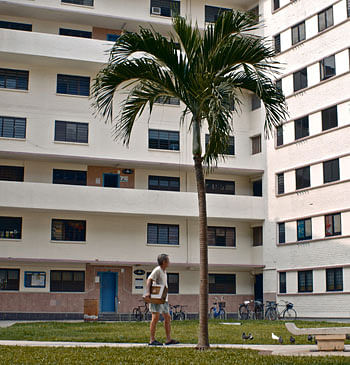
Director: Royston Tan
Movie: 3688 (2015)
Location: Dakota Crescent
Director Tan sought to preserve the past on film in the collaborative works Old Places (2010) and Old Romances (2012), which featured old locations around Singapore and the significance they held for people.
Shooting at Dakota Crescent for his upcoming work 3688 continues that trajectory, taking it from the realm of documentary into the territory of fiction.
Tan, 38, hopes the act of filming a place can help to preserve it, at least in people's memories and so "disappearing fragments of society will not be forgotten".
Singer Joi Chua makes her acting debut as a parking attendant named Fei Fei, whose idol is the late Taiwanese legend Fong Fei-fei. The film features a lot of carpark scenes in Dakota Crescent, given the protagonist's occupation.
Tan wanted to shoot there "as this estate would be gone by next year".
He adds: "There are many important pieces of history in this small neighbourhood, such as the first-generation HDB buildings, old playground and even old lifts left untouched from the past. This place is irreplaceable as every place has its own set of unique elements and no other location can replace the memories shared in Dakota Crescent."
The three-week shoot in the "quiet and friendly neighbourhood" went pretty smoothly - the kind folks at Tian Kee & Co cafe even provided the crew with electricity for the shoot.
But the cast and crew had to work around a game of Bingo held every Monday and Wednesday by the community centre for the elderly.
Tan notes with a laugh: "People get very excited over the Bingo session and we would have to wait for the event to end. The people were very thoughtful and ended their game early just so we could start our shoot."
Boon Chan
